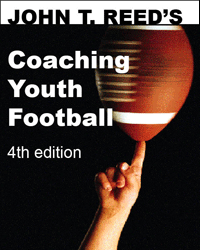What’s the ideal sport for the small child? Would you believe youth football? by John T. Reed


[The following is a news release we used in 1993 to try to improve our recruiting. You may use it at your program if you wish.]
You say your child is small for his age? You say he loves youth sports, but struggles every season against his bigger, stronger, faster peers? Is that what’s bothering you, parent? Well, cheer up! There’s one youth sport right in your own area that will let your child play against kids his own size: youth football.
Almost all youth sports group kids by age alone. That pits big kids against little kids—with predictable results. In this era when parents try to build their child’s self esteem, youth sports usually have the opposite effect on the smaller child.
It doesn’t have to be. All sports should group children by both age and weight. Until they do however, parents of the smaller child have only one size-grouped alternative: youth football.
In fact, youth football has a special category called “older/lighter” for eleven, twelve, and thirteen year olds who are especially small. Here are the age-weight divisions for the league the San Ramon Bears play in—California Youth Football.
| Age | Jr. Pee Wee | Pee Wee | Jr. Midget | Midget |
| 8 | 50-85 lb | — | — | — |
| 9 | 50-85 | 65-100 | — | — |
| 10 | 50-85 | 65-100 | 85-120 | — |
| 11 | 50-65* | 65-100 | 85-120 | 95-140 |
| 12 | — | 65-85* | 85-120 | 95-140 |
| 13 | — | — | 85-100* | 95-140 |
| 14 | — | — | — | 95-140 |
* = older/lighters
Older/lighters are quite small for their age, but they are so highly sought after by coaches for their athletic maturity and experience that league rules permit no more than eight older/lighter players per team. What other youth sport has to stop coaches from recruiting too many small players?
“We wish we had more older/lighters,” says Pee Wee head coach Pat Elliott. “They are invariably team leaders and star players. So far, we’ve never had more than one older/lighter per team. And some years we have none.”
Smaller kids who are not quite older/lighters still benefit from the weight groupings. A 55-pound ten-year old might collide with a classmate twice his weight on the soccer or Little League field. But in youth football, one would be a Jr. Pee Wee, the other a Jr. Midget.
“One of the main objections we hear from parents about youth football is, ‘Oh, my son is too small,’” says Bears president Gale Elliott. “But the fact is not only is that not a valid objection because of our weight limits, we are the best sport for the small child because we’re the only one that insists he play with the kids his own size.”
Youth football weight limits are strictly enforced for safety and competitive reasons. All players must weigh in just before each game. A weighmaster from each team and a California Youth Football official observe each team’s weigh in—checking each player against a loose-leaf binder containing his certified color photograph, height, and weigh-in history. To allow for during-the-season growth, the limits are raised by one pound a week most weeks of the season.
Sadly, youth football may be the last chance for smaller kids to play tackle football. High school football groups by age only. The resulting physical mismatches are one of the main reasons for collision injuries at the higher levels of football. The prohibition against physical mismatches in youth football is one of the main reasons organized tackle football has one of the best safety records among organized sports for kids age eight to fourteen.
John T. Reed